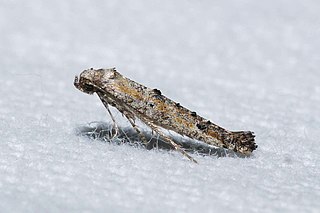Related Research Articles
Epermenia infracta is a moth in the family Epermeniidae. It was described by Annette Frances Braun in 1926. It is found in North America, where it has been recorded from Alberta, Colorado, Oregon and California.
Agonopterix gelidella is a moth in the family Depressariidae. It was described by August Busck in 1908. It is found in North America, where it has been recorded from Alberta, Maine, Manitoba and North Carolina.
Agonopterix nigrinotella is a moth in the family Depressariidae. It was described by August Busck in 1908. It is found in North America, where it has been recorded from Arkansas, Illinois, Indiana, Maine, Maryland, Michigan, Minnesota, New York, Ohio, Ontario, Quebec and Wisconsin.
Agonopterix pergandeella is a moth in the family Depressariidae. It was described by August Busck in 1908. It is found in North America, where it has been recorded from Minnesota and Nebraska.

Agonopterix senicionella is a moth in the family Depressariidae. It was described by August Busck in 1902. It is found in North America, where it has been recorded from Kentucky, Michigan, Ohio, Virginia and West Virginia.
Depressaria juliella is a moth in the family Depressariidae. It was described by August Busck in 1908. It is found in North America, where it has been recorded from Washington, Oregon, Wyoming, Utah and New Mexico.
Nites betulella, the black-dotted birch leaftier moth, is a moth in the family Depressariidae. It was described by August Busck in 1902. It is found in North America, where it has been recorded from Nova Scotia, southern Canada, the north-eastern United States, British Columbia and Wisconsin.
Nites maculatella is a moth in the family Depressariidae. It was described by August Busck in 1908. It is found in North America, where it has been recorded from Vermont, Ontario, Pennsylvania, Ohio, Indiana, Kentucky, Maine, Maryland and West Virginia.

Epermenia is a genus of moths in the family Epermeniidae. The genus was first described by Jacob Hübner in 1825.
Epermenia ergastica is a moth in the family Epermeniidae. It was described by Edward Meyrick in 1917. It is found in Indonesia, where it has been recorded from the Tenimbar Islands.
Epermenia xeranta is a moth in the family Epermeniidae. It was described by Edward Meyrick in 1917. It is found in Australia, where it has been recorded from Queensland.
Epermenia stolidota is a moth in the family Epermeniidae. It was described by Edward Meyrick in 1917. It is found in North America, where it has been recorded from Wyoming, Colorado, Utah and Arizona.
Epermenia epispora is a moth in the family Epermeniidae. It was described by Edward Meyrick in 1897. It is found in Australia, where it has been recorded from Queensland and New South Wales.

Epermenia exilis is a moth in the family Epermeniidae. It was described by Edward Meyrick in 1897. It is found in Australia, where it has been recorded from South Australia and New South Wales.
Epermenia symmorias is a moth in the family Epermeniidae. It was described by Edward Meyrick in 1923. It is found in Fiji.
Epermenia trileucota is a moth in the family Epermeniidae. It was described by Edward Meyrick in 1921. It is found in Australia, where it has been recorded from South Australia.
Epermenia cicutaella is a moth in the family Epermeniidae. It was described by William D. Kearfott in 1903. It is found in North America, where it has been recorded from California, Delaware, Kentucky, Michigan, New Brunswick, New Hampshire, New Jersey, New York, Nova Scotia, Oregon, Quebec, and Wyoming.
Epermenia imperialella is a moth in the family Epermeniidae. It was described by August Busck in 1906. It is found in North America, where it has been recorded from Manitoba, Alberta, Iowa and Pennsylvania.
Epermenia pimpinella is a moth in the family Epermeniidae. It was described by Mary Murtfeldt in 1900. It is found in North America, where it has been recorded from South Carolina, Ohio, Illinois, Arkansas and Oklahoma.
Gnorimoschema alaricella is a moth in the family Gelechiidae. It was described by August Busck in 1908. It is found in North America, where it has been recorded from California, Kentucky, New Hampshire, Ohio and Pennsylvania.
References
- 1 2 Busck, A. (1908). "Descriptions of some new microlepidoptera from Pennsylvania". The Canadian Entomologist. 40: 193–196 [195].
- ↑ Beccaloni, G.; Scoble, M.; Kitching, I.; Simonsen, T.; Robinson, G.; Pitkin, B.; Hine, A.; Lyal, C., eds. (2003). "Epermenia albapunctella". The Global Lepidoptera Names Index . Natural History Museum . Retrieved May 18, 2018.
- ↑ "520006.00 – 2328 – Epermenia albapunctella – Busck, 1908". North American Moth Photographers Group. Mississippi State University. Retrieved June 22, 2018.
- ↑ Gaedike, Reinhard (2008). "New species and records of the Nearctic Epermeniidae (Lepidoptera)" (PDF). Tijdschrift voor Entomologie. 151: 57–64.
- ↑ Entz, Chuck (July 8, 2011). "Species Epermenia albapunctella - Hodges#2328". BugGuide.Net. Retrieved June 22, 2018.
 This article incorporates text from this source, which is in the public domain .
This article incorporates text from this source, which is in the public domain .